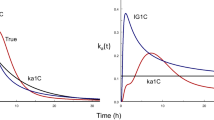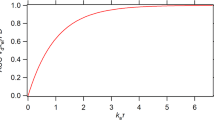Abstract
Purpose. To develop a simple approach for investigating absorption kinetics, which does not require modeling assumptions or intravenous data.
Methods. The concentration (C) -time (t) data are plotted as a phase plane plot (dC/dt versus C). Errorless C,tdata were generated from one and two compartment models employing first-order, zero-order and Michaelis-Menten input kinetics, and the phase plane plots were constructed. A simple test based on the ratio of slopes of the separate linear regression analyses of absorption and elimination data of the phase plane plot is proposed to justify or not the presence of zero-order input kinetics. Errant data were used to assess the performance of the test developed. Literature data of theophylline and nitroglycerin formulations were analyzed using the phase plane plot. Input rate-time profiles were constructed for one compartment model drugs utilizing the data of the phase plane plot.
Results. The geometric forms of the phase plane plots derived from the errorless data of the various pharmacokinetic models were found to be indicative of the absorption kinetics. Very good results were obtained when the test for the discernment of absorption kinetics was applied to errant data. Zero-order absorption kinetics were justified (i) for the transdermal absorption of nitroglycerin and (ii) only for a certain period of time, for the gastrointestinal absorption of theophylline.
Conclusions. Investigation of absorption kinetics can be accomplished with the phase plane method. The cumulative character of the classical percent absorbed versus time plots can be misleading in justifying the presence of zero-order input kinetics.
Similar content being viewed by others
REFERENCES
J. G. Wagner and E. Nelson. Per cent absorption time plots derived from blood level and urinary excretion data. J. Pharm. Sci. 52:610-611 (1963).
J. G. Wagner. Application of the Wagner-Nelson absorption method to the two compartment open model. J. Pharmacokin. Biopharm. 2:469-486 (1974).
J. C. K. Loo and S. Riegelman. New method for calculating the intrinsic absorption rate of drugs. J. Pharm. Sci. 57:918-928 (1968).
P. Veng-Pedersen. Internal deconvolution — a method for evaluating in vivorelease, in vivo—in vitrocorrelation, and drug absorption, not requiring separate reference administration. Pharm Res. 12:S-369 (1995).
F. Podczeck, K. M. Charter, M. Newton, and K. Yuen. Calculation of the drug absorption rates of two sustained-release theophylline formulations using quantified maximum entropy. Eur. J. Pharm. Biopharm. 41:254-261 (1995).
Z. Yu, S. S. Hwang, and K. S. Gupta. DeMonS-A new deconvolution method for estimating drug absorbed at different time intervals and/or drug disposition model parameters using a monotonic cubic spline. Biopharm. Drug Dispos. 18:475-487 (1997).
C. M. Metzler, G. K. Elfring, and A. J. McExen. A package of computer programs for pharmacokinetic modeling. Biometr. 30:562 (1974).
H. Cheng and W. J. Jusko. The area function method for assessing the drug absorption rate in linear systems with zero-order input. Pharm Res. 6:133-139 (1989).
X. Liu, K R. Brouwer, and G. M. Pollack. A modified residual method to estimate the zero order absorption rate constant in a one compartment model. Biopharm. Drug Dispos. 18:93-101 (1997).
D. B. Marghitu, S. A. Kincaid, and P. F. Rumph. Nonlinear dynamics stability measurements of locomotion in health greyhounds. Am. J. Vet. Res. 57:1529-1535 (1996).
O. Tchernichovski and I. Golani. A phase plane representation of rat exploratory behavior. J. Neurosci. Methods. 62:21-27 (1995).
J. D. Cooke and S. H. Brown. Phase plane tracking: a new method for shaping movements. Brain Res. Bull. 16:435-437 (1986).
H. S. Karagueuzian, S. S. Khan, T. A. Denton, M. Gotoh, W. J. Mandel, and G. A. Diamond. Phase plane plot of electrograms as a marker of ventricular electrical instability during acute ischemia: initial experimental results and potential clinical applications. Pacing Clin. Electrophysiol. 15:2188-2193 (1992).
A. Fonseca-Costa, P. Magrassi, W. A. Zin, and L. J. M. Romeo Jr. Detection and quantification of small right-to-left shunts by the phase-plane method. Am. J. Physiol. 247:H517-H522 (1984).
J. M. van Rossum, J. E. G. M. de Bie, G. van Lingen, and H. W. A. Teeuwen. Pharmacokinetics from a dynamical systems point of view. J. Pharm. Biopharm. 17:365 (1989).
P. Macheras, P. Argyrakis, and C. Polymilis. Fractal geometry, fractal kinetics and chaos en route to biopharmaceutical sciences. Europ. J. Drug Metab. Pharmacok. 21:77-86 (1996).
S. Wiggins. Introduction to applied nonlinear dynamical systems and chaos. Springer-Verlag, New York, 1990.
A Garfinkel. Mathematics for physiology. Am. J. Physiol. 245:R455-R466, (1983).
A. Yakobi and E. Halperin Valega. Oral sustained release formulations: Design and Evaluation. Pergamon Press, New York, p. 166, 1988.
E. A. Cefali, C. R. Banfield, M. A. Gonzalez, and J. G. Wagner. In vivo determination of zero-order absorption from transdermal glycerol trinitrate system. Eur. J. Pharm. Biopharm. 39:140-143 (1993).
P. Veng-Pedersen and N. B. Modi. Optimal extravascular dosing intervals. J. Pharmacokin. Biopharm. 19:405-412 (1991)
Author information
Authors and Affiliations
Rights and permissions
About this article
Cite this article
Dokoumetzidis, A., Macheras, P. Investigation of Absorption Kinetics by the Phase Plane Method. Pharm Res 15, 1262–1269 (1998). https://doi.org/10.1023/A:1011952227079
Issue Date:
DOI: https://doi.org/10.1023/A:1011952227079




